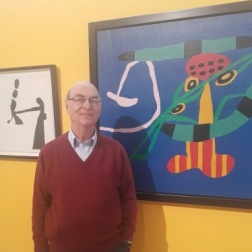
Lifestyle/Community

Battiss ‘in totality’ at Wits Art Museum with some 700 pieces
MARGOT COHEN
Pictured: Jack Ginsberg stands at one of his favourite Fook period paintings of artist Walter Battiss. Ginsberg has donated his 700-piece collection to Wits Art Museum.
Over more than 35 years Ginsberg assembled an extraordinary collection of 700 artworks, books and ephemera on Battiss. The collection, currently on view at Wits Art Museum (WAM) has been donated to WAM by Ginsberg. The exhibition runs until October 9.
The exhibition has been divided into five sections, culminating in Battiss’ legendary Fook period. Viewers can walk step-by-step through Battiss’ life and gain insight into his rock painting, calligraphy, silk screens, woodcuts and, of course Fook Island. There is also a “risque section” which may shock some viewers.
The first period is about the artist’s life as a student, artist and teacher during the 1920s.
Born in Somerset East, Battiss lived in Fauresmith in the Free State where he matriculated. He became a clerk in the magistrate court in Rustenburg, spending his leisure hours painting the surrounding landscape.
He gained his teaching diploma and by 1933 was appointed art master at Pretoria Boys’ High School where his dynamic influence was to operate with interruptions for almost 30 years.
In 1938, after his first visit to Europe and meeting with Henri Breuil, the French priest and archaeologist and expert on cave paintings, Battiss published his first book “The Amazing Bushman”.
Battiss married art educationist Grace Anderson and started to acquire symbolic characters in his works, while he also worked on woodcuts.
By 1944 Battiss was exhibiting copies of rock paintings in Johannesburg. He undertook an expedition to the Namib Desert in 1948 where he lived among the Bushmen and won an award for painting and woodcut at the International Olympiad Exhibition in London.
During this period he met Pablo Picasso, whose creative styles transcend realism and abstraction, Cubism Neoclassicism, Surrealism and Expressionism. Picasso’s influence soon became evident in Battiss’ watercolours.
This second phase of the exhibition, Battiss called fragments of African history – “but they are also fragments of myself” Battiss said.
By 1952 the artist was invited to lecture on South African art at the University of London. Silkscreen and woodcuts by him were prolific during this third phase.
During the 1960s Battiss was exploring and travelling in East Africa and Greece. A notable work during this phase was his famous African Paradise of 1961/62.
Battiss was one of the first South African artists to incorporate African culture and indigenous history in his work.
As an international artist, traveller and philosopher, Battiss was many things to many people. He wrote 10 books and is considered an international authority on cave and erotic art.
Silhouettes which date from 1968 – 1978, form another section of the exhibition.
The fifth phase of the exhibition is Fook – an imaginary island created by Battiss, a place with its own currency, postal code and language, and is connected to his five trips to Greece where he visited 16 islands and produced 54 screen prints.
Battiss became a Fellow of the Royal College of Art, London and the International Institute of Arts and Letters, Zurich.
His hippie-like stance and unquenchable thirst for knowledge, extended to travels and research.
This collection will become part of WAM’s permanent holdings and forms the nucleus of a major Battiss archive, which will be available to scholars for research.





noel durie
July 8, 2016 at 3:12 pm
‘I have today submitted a large \”Silouettes\” oil to Strauss for sale in October’